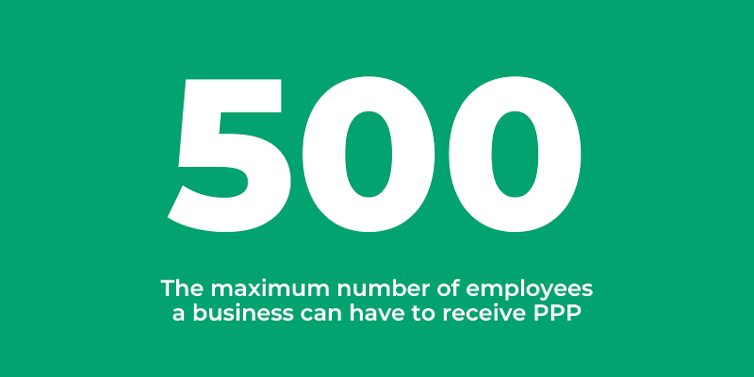Can a business still be small with 500 employees?
- Written by Charles Chear, Lecturer and Ph.D. student, Rutgers University
 Significant Figures[1] is a series from The Conversation where scholars explain an important number in the news.
Significant Figures[1] is a series from The Conversation where scholars explain an important number in the news.
 The distribution of Paycheck Protection Program[2] loans for small businesses hasn’t been smooth, from unclear guidelines[3] to technical problems[4].
A most disconcerting issue has been large and wealthy[5] businesses being able to obtain the loan, while much smaller businesses have not.
While some attribute it to pressure being put on government and banks to release loans as quickly as possible[6], as a scholar of microbusinesses and the informal economy[7], I believe much of the public’s frustration with how the PPP was paid out is related to how the federal government defines small business.
What is a small business?
When most of us think of small businesses[8], we imagine a local business such as our favorite pizzeria on Main Street[9], the bodegas[10] and street vendors[11] in New York City or even our local plumber.
My own research[12] focuses on the social welfare of immigrant families that run such businesses. Often with just a handful of employees – and in many cases, just one – these businesses are nowhere close to the limit of 500 employees the government used to limit qualification for the PPP loan.
Businesses with fewer than 10 employees are known as a microbusiness[13] to researchers. They are the most common type[14] of business in the United States.
Yet were we to ask microbusiness owners if they have heard of the term microbusiness, most would likely say no.
In fact, researchers and policymakers define small business in a number of ways, some of which make more sense than others.
The distribution of Paycheck Protection Program[2] loans for small businesses hasn’t been smooth, from unclear guidelines[3] to technical problems[4].
A most disconcerting issue has been large and wealthy[5] businesses being able to obtain the loan, while much smaller businesses have not.
While some attribute it to pressure being put on government and banks to release loans as quickly as possible[6], as a scholar of microbusinesses and the informal economy[7], I believe much of the public’s frustration with how the PPP was paid out is related to how the federal government defines small business.
What is a small business?
When most of us think of small businesses[8], we imagine a local business such as our favorite pizzeria on Main Street[9], the bodegas[10] and street vendors[11] in New York City or even our local plumber.
My own research[12] focuses on the social welfare of immigrant families that run such businesses. Often with just a handful of employees – and in many cases, just one – these businesses are nowhere close to the limit of 500 employees the government used to limit qualification for the PPP loan.
Businesses with fewer than 10 employees are known as a microbusiness[13] to researchers. They are the most common type[14] of business in the United States.
Yet were we to ask microbusiness owners if they have heard of the term microbusiness, most would likely say no.
In fact, researchers and policymakers define small business in a number of ways, some of which make more sense than others.
 Many bodegas are actually considered microbusinesses, not just small businesses.
AP Photo/Bebeto Matthews[15]
The federal definitions
The Small Business Administration, the department overseeing the PPP loan, uses a size standard[16] to determine what qualifies as a small business for SBA and federal contracting programs.
The standard is measured by number of employees or average annual receipts[17] and varies by industry[18], with 500 employees as the most common standard.
The PPP loan program waives rules[19] found in general SBA loans to include businesses, such as nonprofits, that are usually not supported. And while a 500-employee limit may seem too generous since it allowed organizations like the LA Lakers[20] to qualify for the PPP loan, it is actually an attempt to narrow down a standard for SBA loans that typically includes[21] businesses with as many as 1,500 employees.
Additionally, a compendium of federal data[22] from the Bureau of Labor Statistics, Internal Revenue Service and other departments suggests that there is no consistent standard defining small business among federal agencies.
A broad, federal definition for small business explains why even some multinational corporations[23] like Singapore-based biotech firm Wave Life Sciences were initially able to obtain PPP loans that they later decided to return. This along with upcoming legislation[24] may give little, or even micro, businesses a better shot.
The Conversation has received funds from the Paycheck Protection Program.
[Insight, in your inbox each day. You can get it with The Conversation’s email newsletter[25].]
Many bodegas are actually considered microbusinesses, not just small businesses.
AP Photo/Bebeto Matthews[15]
The federal definitions
The Small Business Administration, the department overseeing the PPP loan, uses a size standard[16] to determine what qualifies as a small business for SBA and federal contracting programs.
The standard is measured by number of employees or average annual receipts[17] and varies by industry[18], with 500 employees as the most common standard.
The PPP loan program waives rules[19] found in general SBA loans to include businesses, such as nonprofits, that are usually not supported. And while a 500-employee limit may seem too generous since it allowed organizations like the LA Lakers[20] to qualify for the PPP loan, it is actually an attempt to narrow down a standard for SBA loans that typically includes[21] businesses with as many as 1,500 employees.
Additionally, a compendium of federal data[22] from the Bureau of Labor Statistics, Internal Revenue Service and other departments suggests that there is no consistent standard defining small business among federal agencies.
A broad, federal definition for small business explains why even some multinational corporations[23] like Singapore-based biotech firm Wave Life Sciences were initially able to obtain PPP loans that they later decided to return. This along with upcoming legislation[24] may give little, or even micro, businesses a better shot.
The Conversation has received funds from the Paycheck Protection Program.
[Insight, in your inbox each day. You can get it with The Conversation’s email newsletter[25].]
References
- ^ Significant Figures (theconversation.com)
- ^ Paycheck Protection Program (www.sba.gov)
- ^ unclear guidelines (www.usatoday.com)
- ^ technical problems (www.nbcnews.com)
- ^ large and wealthy (www.cnbc.com)
- ^ government and banks to release loans as quickly as possible (www.nytimes.com)
- ^ a scholar of microbusinesses and the informal economy (socialwork.rutgers.edu)
- ^ small businesses (www.sba.gov)
- ^ on Main Street (www.mainstreetalliance.org)
- ^ bodegas (ny.eater.com)
- ^ street vendors (streetvendor.org)
- ^ own research (socialwork.rutgers.edu)
- ^ microbusiness (aeoworks.org)
- ^ most common type (www.sba.gov)
- ^ AP Photo/Bebeto Matthews (www.apimages.com)
- ^ size standard (www.sba.gov)
- ^ average annual receipts (www.law.cornell.edu)
- ^ varies by industry (www.sba.gov)
- ^ waives rules (www.sgrlaw.com)
- ^ LA Lakers (www.npr.org)
- ^ typically includes (www.natlawreview.com)
- ^ compendium of federal data (gwipp.gwu.edu)
- ^ multinational corporations (www.forbes.com)
- ^ upcoming legislation (www.vox.com)
- ^ You can get it with The Conversation’s email newsletter (theconversation.com)
Authors: Charles Chear, Lecturer and Ph.D. student, Rutgers University
Read more https://theconversation.com/can-a-business-still-be-small-with-500-employees-137449

